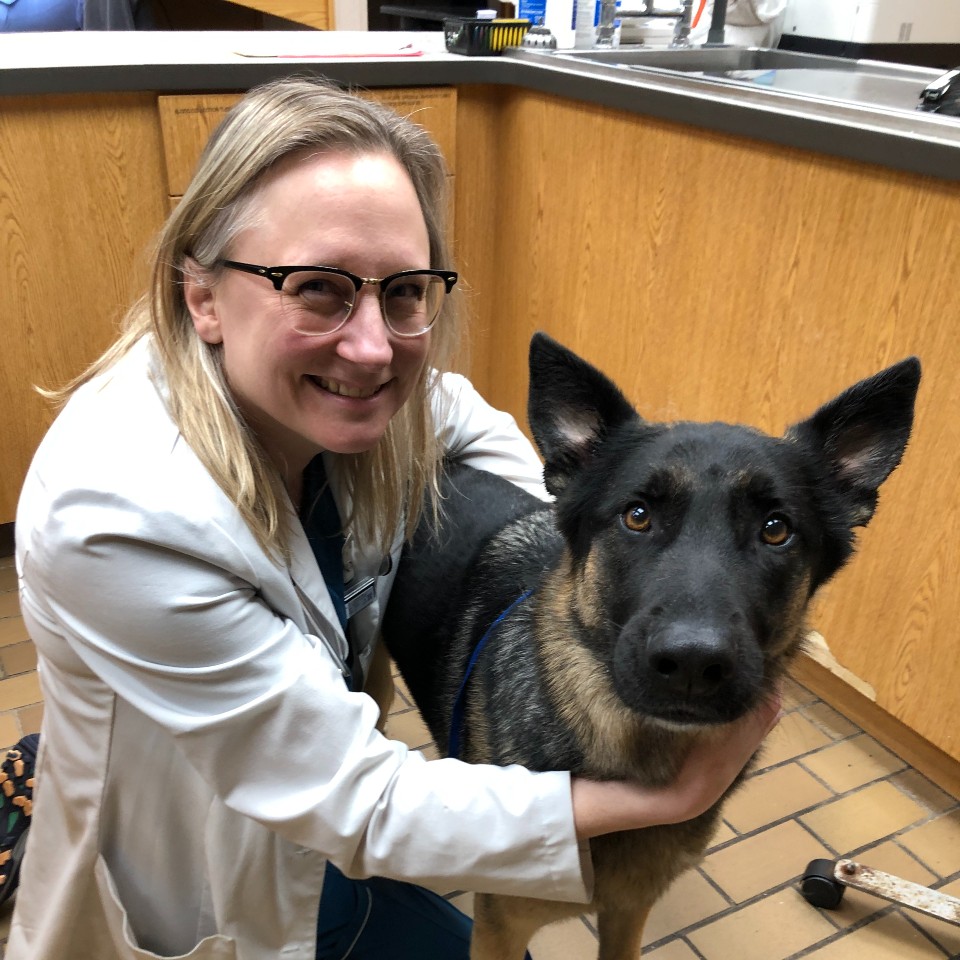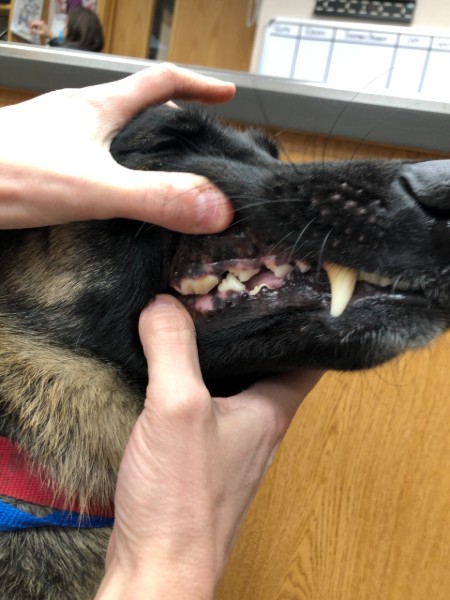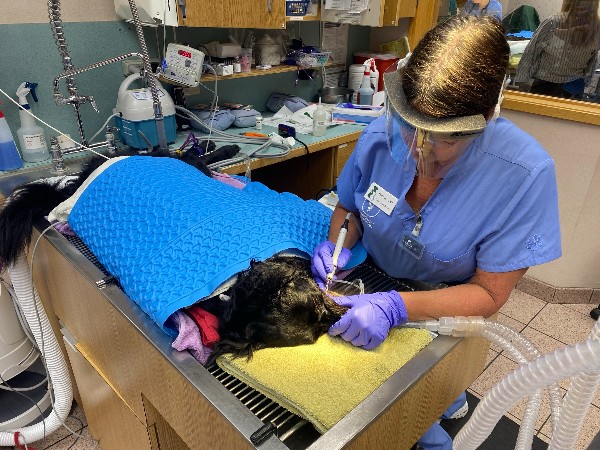
Healthly teeth, happy smiles: Pet Dental Health Month
From an early age, we’re taught regular habits to maintain healthy teeth and gums. What you might not know as a pet owner is the big role dental hygiene also plays in your cat or dog’s overall health. Although February is National Pet Dental Health Month, at CHFA and BVAC we stress the importance of caring for your pet’s teeth all year long.
 Dr. Malik with her own dog, Bhaloo.According to Dr. Laura Malik, dogs and cats alike need routine care and monitoring of their dental health, and the implications of dental problems go beyond bad breath. “The obvious issues are living with chronic pain that would come from broken teeth or infection, things that would affect their overall quality of life,” she said. “But with animals that are living with chronic dental disease, we also often see health problems in the rest of their body too. For instance, they can get bacteria that will move on to the kidneys and so they’ll have a faster decline of kidney function. Or if they're living with chronic inflammation it can cause some liver parameters to go up or cause a faster progression of certain types of heart disease.”
Dr. Malik with her own dog, Bhaloo.According to Dr. Laura Malik, dogs and cats alike need routine care and monitoring of their dental health, and the implications of dental problems go beyond bad breath. “The obvious issues are living with chronic pain that would come from broken teeth or infection, things that would affect their overall quality of life,” she said. “But with animals that are living with chronic dental disease, we also often see health problems in the rest of their body too. For instance, they can get bacteria that will move on to the kidneys and so they’ll have a faster decline of kidney function. Or if they're living with chronic inflammation it can cause some liver parameters to go up or cause a faster progression of certain types of heart disease.”
Common but overlooked
Part of the reason for dedicating a whole month to pet dental health is that it is “one of the most common problems an animal will have and it's also one of the most commonly overlooked problems,” said Dr. Malik. “A lot of times, as owners, we don’t pick up on the changes in the mouth and most often the patients aren’t acting sick from dental disease because they have accustomed themselves to the gradual changes as they occur.”
Adding to the issue is the fact that pet owners often don’t realize their dogs or cats are experiencing tooth pain because the pet is still eating regularly. “We give them bite size food so they can avoid the areas that hurt,” said Dr. Malik. “So the signs of tooth damage can be subtle. Once we had a dog come in with an advanced infection and we removed some of the painful teeth and treated the infection. A few weeks later the owner, who hadn’t perceived there was a problem before we found the infection, told us the dog’s whole butt was wiggling again when he wagged his tail! He hadn’t done that in years and they thought it had been because he was getting older. So healthy teeth can make an incredible difference in their quality of life.”
Getting graded Dr. Malik examines the teeth of her dog, Bhaloo.
Dr. Malik examines the teeth of her dog, Bhaloo.
At CHFA and BVAC, we grade your pet’s dental health to help us determine what, if any, treatment from us is necessary. Cleanings that take place in our office don’t follow a specific pattern, according to Dr. Malik, who said, “Routine dentistry is like a unicorn. We know what it looks like but we never see it.”
“What we do during dental cleanings in our office varies depending on the grade,” she said. “Are we expecting to be able to do just a cleaning as a pure maintenance situation? Or are we seeing signs of gum disease or bad breath already? At our clinic, we’d call that grade one, where there’s heavy tartar that needs to be cleaned but we don’t anticipate problems or see areas with gingivitis. At grade two, there’s gingivitis, the gumline is inflamed, and we’re not sure what’s going on underneath that tarter. So we go into it cautiously optimistic but reserving extra time in case we find something. Starting at grade three, we see areas with advanced changes. We can see areas where there's some bone loss. And the grade fours are the ones that are the most involved, where the majority of the teeth have some infection and are going to need some advanced care.”
 Veterinary Technician Debbie has performed dental cleanings for us for decades.Before the procedure, the pet is anesthetized and given necessary pain or anxiety medication. During the procedure, a licensed technician monitors the pet’s vital signs and cleans the teeth using ultrasonic cleaning to hit the large areas of tartar and hand scaling to remove debris above and below the gumline.
Veterinary Technician Debbie has performed dental cleanings for us for decades.Before the procedure, the pet is anesthetized and given necessary pain or anxiety medication. During the procedure, a licensed technician monitors the pet’s vital signs and cleans the teeth using ultrasonic cleaning to hit the large areas of tartar and hand scaling to remove debris above and below the gumline.
The doctor performing the cleaning then charts and evaluates each tooth, looking for signs of problems. “Is there injury to the crown? Is there evidence of periodontal disease? We take x-rays to give us a view of what is going on below the gumline. If we find something, such as an abscessed tooth, we take care of it right there while they’re under sedation,” said Dr. Malik.
Healthy at home
While we encourage regular dental cleanings in our office, good tooth cleaning habits at home can help prevent major problems down the road fairly easily. Daily brushing prevents the plaque on pets’ teeth from turning into tartar.
“Daily tooth brushing is the gold standard. It’s not as difficult as it sounds because you need either a soft bristle brush or a finger mitt and you rub the sides of the teeth for just a minute or so,” said Dr. Malik. “But there are some pets where you just can’t get them to cooperate, and for them there are products approved by the Veterinary Oral Health Council (VOHC) such as dental chews or treats that you can give your dog daily. It’s got to be something that everybody can live with, or it just isn’t going to work.” Prevention at home can go a long way in keeping your pet from reaching the higher grades of the scale.



